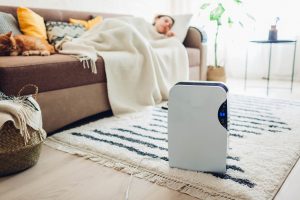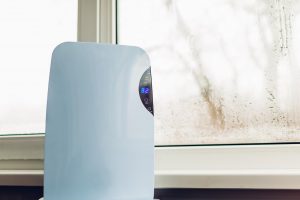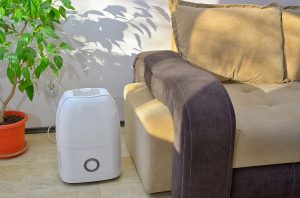If you’ve ever spent a lot of time in certain rooms of your home like the bathroom, or even the laundry room, you’ll know just how warm it can get on rainy days.
A common telltale sign of extreme humidity in your space is condensation on the windows, clammy conditions, musty odours, and damp spots on the ceilings or walls.
When you use a dehumidifier, it pulls the moisture from the air and collects water in a removable tank. So, please read on as we dive into everything you need to know about dehumidifiers.
Contents
- 1 Key Takeaways
- 2 How Do You Use a Dehumidifier?
- 3 Dehumidifier Placement
- 4 How To Maintain A Dehumidifier For Optimal Operation
- 4.1 1. Review The Owners Manual
- 4.2 2. Adjust The Humidistat
- 4.3 3. Replace The Filter
- 4.4 4. Close Windows and Doors
- 4.5 5. Clean the Water Tank Every Now and Again
- 4.6 6. Don’t Short-cycle a Compressor Dehumidifier
- 4.7 7. Inspect The Condenser Coils Regularly
- 4.8 8. Clean The Air Grilles
- 4.9 9. Using The Drainage Option
- 5 Dehumidifier FAQ
- 6 Heat Pump Source: Reliable Heating and Cooling Solutions
- 7 Conclusion
Key Takeaways
- Before using a dehumidifier, determine the correct size for your space based on square footage and moisture levels. Consult a buying guide for guidance.
- Place the dehumidifier strategically in rooms with high humidity, such as bathrooms, kitchens, basements, and children’s rooms, considering sources of moisture and airflow.
- Proper maintenance is essential for optimal dehumidifier operation, including cleaning the filter, water tank, and condenser coils, adjusting settings, and ensuring proper drainage. Dehumidifiers should only run when humidity levels are over 50%.
How Do You Use a Dehumidifier?
Before you can get into using your dehumidifier, you’ll need first to determine the correct size for your space. So, it’s a good idea to measure the square footage in your home and then inquire about the dehumidifier’s size. After sizing the area, you’ll then need to select the most optimal capacity.
 Dehumidifiers are often sized according to the amount of moisture present in your room, if you didn’t already know. In essence, this is often measured using pints of water that will be removed during a 24-hour timeframe. So, before buying a dehumidifier, it’s a good idea to consult with a buying guide.
Dehumidifiers are often sized according to the amount of moisture present in your room, if you didn’t already know. In essence, this is often measured using pints of water that will be removed during a 24-hour timeframe. So, before buying a dehumidifier, it’s a good idea to consult with a buying guide.
For spaces such as basements or large rooms, it is recommended that larger ones be used. This ensures that the moisture is pulled from within the space and you won’t be required to empty the reservoir.
It should also be noted that larger machines are costly and can use a great deal of electricity.
According to industry experts, it is recommended that dehumidifiers be used for various rooms in your home. This just means that if your bathroom and your pool room require dehumidifiers, individual ones should be bought as long as they were designed for the area. However, if you intend to move your unit from one room to another, it’s best to get the portable variant.
Portable dehumidifiers are light and easy to transport from room to room. If, for some reason, multiple rooms in your home require the use of dehumidifiers, then it is recommended that you install one with your HVAC system so that it can facilitate multiple spaces at a time. Besides the technical aspects, you’ll also need to think about the technical side of it.
Not all dehumidifiers are capable of offering the same services as each other. Some come with adjustable humidistats, built-in hygrometers, auto-shutoff and defrost settings. So, before you begin using one, it’s best to take all of these into consideration and check our list of the best dehumidifers in the UK.
Dehumidifier Placement
Bathroom
If you usually take hot showers, it is recommended that the dehumidifier be run inside the room after a shower. The average runtime should be about 20 minutes to ensure that the humidity is removed from within the room. Since there is possibly less floor space, a small unit can be placed on top of your toilet bowl or on top of a shelf.
Kitchen
Your kitchen can be thought of as a never-ending source of humidity in your home. Everything from sinks, refrigerators, dishwashers and even cooking will generate some level of humidity in your kitchen.
So, if the humidity is closer to your sink, it is recommended that the dehumidifier be placed close to the sink. If the room becomes humid when you cook, it is recommended that you put the humidifier close to the stove while maintaining the airflow.
Basement
More than often enough, basements tend to become very humid since they are located underground. Additionally, they are also even more vulnerable to water seepage. Most basements are not properly ventilated, so the humidity builds very quickly.
Since there is already some form of plumbing in your basement, you’ll be able to drain the tanks very easily. So, if you have a large basement, it is recommended that the rating is enough to cover the area. Don’t forget to put the dehumidifier next to objects that generate heat.
Child’s Room
When it comes to your child’s overall health, you must use a dehumidifier in their room. The right humidity levels in their room will reduce the allergens and help them sleep better at night. While bedrooms are not prone to high humidity levels, leaky windows can change all of that.
If there are cracks in or around the window, moisture from the outside can seep in. As this occurs, the humidity increases. However, it should be noted that houseplants also contribute to a great deal of humidity in your home. Since bedrooms are small, it is recommended that you find a well-ventilated place in the middle to put the dehumidifier.
Instructions for Placement in Any Kind of Room
Placing your dehumidifier is important if you’re expecting optimal results. Dehumidifiers work their best when they are placed close to the source of moisture in the room.
Depending on the size of your room, you’ll need to place it in suitable places. Larger rooms require it to be placed in the middle, while smaller rooms don’t require any special placement strategy.
Additionally, you’ll need to look out for objects that can block the airflow out or into the dehumidifier.
So, keep in mind that dehumidifiers should not be placed in areas that too close to the wall to furniture. If ever the airflow is restricted, the unit would fail.
It’s best to also remember that you’ll need to ensure that you properly maintain it and keep it away from dust and dirt since it is another piece of machinery.
How To Maintain A Dehumidifier For Optimal Operation
1. Review The Owners Manual
Before you get to cleaning your dehumidifier, it is advised that you consult with the manual for special conditions. The manual will indicate how you can drain and place the unit.
2. Adjust The Humidistat
During your routine maintenance, the humidistat should be turned off.
3. Replace The Filter
 Most if not all dehumidifiers come fitted with an air filter. These filters ensure that all harmful particles from within the atmosphere, such as allergens and dust, are removed. In essence, the filter works hard to remove the impurities while creating healthier and cleaner dehumidifier air.
Most if not all dehumidifiers come fitted with an air filter. These filters ensure that all harmful particles from within the atmosphere, such as allergens and dust, are removed. In essence, the filter works hard to remove the impurities while creating healthier and cleaner dehumidifier air.
Filters also work to protect your dehumidifier’s internal components and promote efficient operations each day. However, the air doesn’t always move as easily as we think. Hence, it becomes harder for the filter to be cleaned or replaced as required. As such, filters should be replaced according to the manufacturer’s instructions.
4. Close Windows and Doors
Before your dehumidifier can operate effectively, you’ll need to close all of the windows and the doors tightly. When this is not done, the unit will be required to work overtime to compensate for the leaks in your space. In essence, this raises the energy bill.
5. Clean the Water Tank Every Now and Again
When you empty your collection tank, this ensures that there is always a fresh supply of water in the tank. If, for some reason, you don’t actively clean the tank with disinfectant or water and soap, you’ll soon have a breeding ground for mildew and mould. As such, you should always monitor the water tank and clean it as needed. However, if the tank appears clean, it should still be occasionally cleaned.
6. Don’t Short-cycle a Compressor Dehumidifier
After turning off the dehumidifier, it should never be turned on again immediately. At least 10 minutes should be given before turning it on again. During the off-time, the pressure in the system would equalize to prevent the compressor from damaging.
If ever the unit is turned off and on quickly, the compressor will overheat. When this occurs, your circuit-breaker will also trip. If your dehumidifier is ever short-cycled, it can lead to a system malfunction which will result in less moisture being removed from your home.
7. Inspect The Condenser Coils Regularly
If your dehumidifier is expected to operate in relatively cool temperatures, the condenser coils may experience some level of frost build-up.
To perform the inspection, you’ll need to turn the unit off so that you can access the internal coils. Upon inspection, you’ll be able to determine if the coils are frosted over or not. If, for some reason, frost builds up, you’ll need to consult with the user manual to rectify the issue.
8. Clean The Air Grilles
If your dehumidifier has dirty grilles, you’ll begin to experience poor performance. The grilles should be cleaned out at the start and end of each season. The grille can be easily cleaned with the use of the vacuum brush attachment. Doing so ensures that debris and dust are removed.
9. Using The Drainage Option
Dehumidifiers should be drained for them to continue working properly after they are filled with condensate. Drainage can be done in a couple of ways. These include gravity drainage, automatic drainage via the condensate pumps and via the built-in condensate pump. After successfully draining the dehumidifier, you’ll be able to use it again.
Dehumidifier FAQ
How Do You Operate a Dehumidifier?
 Since not all dehumidifiers can work in different spaces, you’ll need to measure the square feet of your room and size the dehumidifier to suit the area.
Since not all dehumidifiers can work in different spaces, you’ll need to measure the square feet of your room and size the dehumidifier to suit the area.
Before the unit can be up and running, you’ll need to adjust the settings. For the most part, between 30% and 50% are usually optimal. If the unit is set to anything below this level, you can expect bacteria to grow in the dryness.
As previously stated, you should always make sure that your dehumidifier is always in a well-ventilated area since they suck in the damp air.
When Should You Use a Dehumidifier?
There is no special time to use a dehumidifier in your home. However, since the summer months bring the most humidity, you may want to use it more during that period. Dehumidifiers can also be used for the following:
- Stuffy, swampy, sticky rooms
- When there is condensation on the windows
- If you smell musty odours
- If mildew and mould grows
- If ever you notice watermarks on the ceilings or walls
- An increase in pests
- Warping or rotting wood
- Extreme allergic reactions to allergens
Can You Leave the Dehumidifier Running All the Time?
While your dehumidifier can run for most of the day, it is not necessary to do so. According to most manufacturers guidelines, dehumidifiers should only be run when the humidity in the room is over 50%.
The optimum humidity comfort level is typically anywhere between 30% and 50%. It should be noted that the humidistat should not be set too low since it not only dries out the room but it also wastes energy.
Is It Safe to Sleep with the Dehumidifier Running?
If the bedrooms in your home are very humid at night, you can safely run the dehumidifier all night long. When the humidity is too high, it can negatively affect your sleep. Sleeping in a humid room will affect your comfort, your breathing and your allergies.
Should You Be Using Dehumidifiers All Year Round?
Since dehumidifiers only have a lifespan of between five to ten years, you must properly care for them. Dehumidifiers are not recommended for the winter months since the atmosphere indoors is naturally dry.
Dehumidifiers work their best during the warmer periods of the year. It should be noted that it is not recommended that you use your dehumidifier in temperatures below 60 degrees F since it can cause frost to build up.
When Will the Dehumidifier Start Working?
On the first use, some dehumidifiers take up to 12 hours before they start working. Others take up to 19 minutes to properly dehumidify the room while removing up to 50%. In some instances, dehumidifiers can even take up to 13 hours to start working.
Heat Pump Source: Reliable Heating and Cooling Solutions
At Heat Pump Source, we take pride in our unwavering commitment to serving the UK with top-tier HVAC solutions. From the efficiency of heat pumps and the cool relief of air conditioning to the warmth of boilers, radiators, and underfloor heating, our dedicated team is always at the forefront of innovation. We understand the unique needs of every household and business, and we strive to provide dependable health and cooling products and services that are tailored just for you. Ensuring your comfort and satisfaction is our utmost priority. Whether you have questions, need guidance, or require support, we’re always here to assist. Please don’t hesitate to contact us; we’re eager to be of service.
Conclusion
As we conclude, we have just looked at how to use a dehumidifier. Dehumidifiers can last up to 10 years if they are properly maintained. Remember, dehumidifiers function their best in hotter environments and should always be placed in a well-ventilated area!
About the Author
At Heat Pump Source, our articles are the product of a collaborative effort among a team of highly skilled HVAC experts. Our dedicated professionals, hailing from diverse backgrounds in heating, ventilation, air conditioning, and refrigeration, contribute their extensive knowledge and experience to every piece of content. This multidisciplinary approach ensures comprehensive coverage. Our commitment is to deliver authoritative, reliable, and tailored advice to meet the unique needs of every household and business across the UK.

